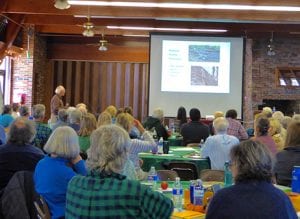
A good crowd showed up for Gary’s talk at the Baltimore County Forestry Board’s workshop, “Healthy Habitats for Native Wildlife.” Photo by Jim Curtis
Among the things Maryland Chapter members enjoy – besides weeding in orchards when temperatures are in the 90s and deburring seeds with the tips of spikes from the burs imbedded in their fingers – is giving presentations on chestnut restoration. In March, Gary Carver gave talks at the Irvine Nature Center in Owings Mills, and at the Baltimore County Forestry Board workshop at the lodge in Oregon Ridge Park in Cockeysville. Combined, his audiences totaled about 250 people. He also gave out almost 100 American chestnut seeds.
At the Irvine Nature Center, his talk was part of the center’s “Eat, Drink and Learn” series of public programs. Gary’s program was titled, “Chestnut Trees and Daiquiris.” (Other talks in the series had titles such as, “Ferns, Spores & Sweet Liqueurs,” “Snowy Hoots & Champagne Flutes,” and “Starry Skies & Mai Tais.”) Gary did not taste the daiquiris—he had Scotch instead!
At the Baltimore County Forestry Board workshop, “Healthy Habitats for Native Wildlife,” Gary met board president Glenn Ferenschak, who is also a Maryland Chapter member, for the first time. Over the last 10 years, on behalf of the Maryland Chapter, Gary has been providing 1,000 American seeds to the Maryland State Tree Nursery. Glenn runs the program that distributes the nursery-grown chestnut seedlings to participating forestry boards throughout Maryland. Gary had been communicating with Glenn via email all those years, without ever meeting him, so it was nice for the two to meet.
Typically, as prelude to his main message, Gary begins with a discussion of the American chestnut tree and the role it played historically and environmentally. He describes the blight, the fungus that causes it, and how the trees are affected. The main thrust of the talk is about what Gary calls the “Paths to Blight Resistance.” He discusses the efforts, goals, and status of seven “paths:” TACF’s backcross breeding, American Chestnut Cooperators’ Foundation’s intercrossing large survivors, genetic modification, hypovirulence and biocontrol, emerging biotechnology, the Phil Rutter genetic storm (“plant everything and let them fight it out”), and natural evolution. He concludes with several questions, such as: How will blight-resistant American chestnut trees be introduced into existing forests? How will we know we have not lost competitive attributes? How will we measure success? How can we apply chestnut restoration as a model for restoration of other species?
Gary was amused when, before the Forestry Board workshop began, a woman came over and said she had heard him talk at the Irvine Nature Center just last week. Trying to be empathetic, Gary said, “I’ll try to say some different things so that you won’t hear the same talk over again.” She responded, “Oh, its OK. I have a bad memory anyway.”
